771 m
Type of resources
Topics
Keywords
Contact for the resource
Provided by
Years
Formats
Representation types
Update frequencies
status
Resolution
-

These files include downscaled historical decadal average monthly snowfall equivalent ("SWE", in millimeters) for each month at 771 x 771 m spatial resolution. Each file represents a decadal average monthly mean. Historical data for 1910-1919 to 1990-1999 are available for CRU TS3.0-based data and for 1910-1919 to 2000-2009 for CRU TS3.1-based data.
-

This set of files includes downscaled projections of decadal means of annual day of freeze or thaw (ordinal day of the year), and length of growing season (numbers of days, 0-365) for each decade from 2010 - 2100 at 771x771 meter spatial resolution. Each file represents a decadal mean of an annual mean calculated from mean monthly data. ---- The spatial extent includes Alaska. Each set of files originates from one of five top ranked global circulation models from the CMIP5/AR5 models and RPCs, or is calculated as a 5 Model Average. Day of Freeze, Day of Thaw, Length of Growing Season calculations: Estimated ordinal days of freeze and thaw are calculated by assuming a linear change in temperature between consecutive months. Mean monthly temperatures are used to represent daily temperature on the 15th day of each month. When consecutive monthly midpoints have opposite sign temperatures, the day of transition (freeze or thaw) is the day between them on which temperature crosses zero degrees C. The length of growing season refers to the number of days between the days of thaw and freeze. This amounts to connecting temperature values (y-axis) for each month (x-axis) by line segments and solving for the x-intercepts. Calculating a day of freeze or thaw is simple. However, transitions may occur several times in a year, or not at all. The choice of transition points to use as the thaw and freeze dates which best represent realistic bounds on a growing season is more complex. Rather than iteratively looping over months one at a time, searching from January forward to determine thaw day and from December backward to determine freeze day, stopping as soon as a sign change between two months is identified, the algorithm looks at a snapshot of the signs of all twelve mean monthly temperatures at once, which enables identification of multiple discrete periods of positive and negative temperatures. As a result more realistic days of freeze and thaw and length of growing season can be calculated when there are idiosyncrasies in the data.
-
This data set consists of PRSIM precipitation climatologies for Alaska in GeoTIFF format. The files in this data set are available from the PRISM Climate Group as text files but have been processed into GeoTIFFs. These are monthly climatologies with a resolution of 771m. Units are millimeters. There are multiple climatological periods currently available through PRISM, but only one is currently available through SNAP in this dataset: 1971-2000.
-
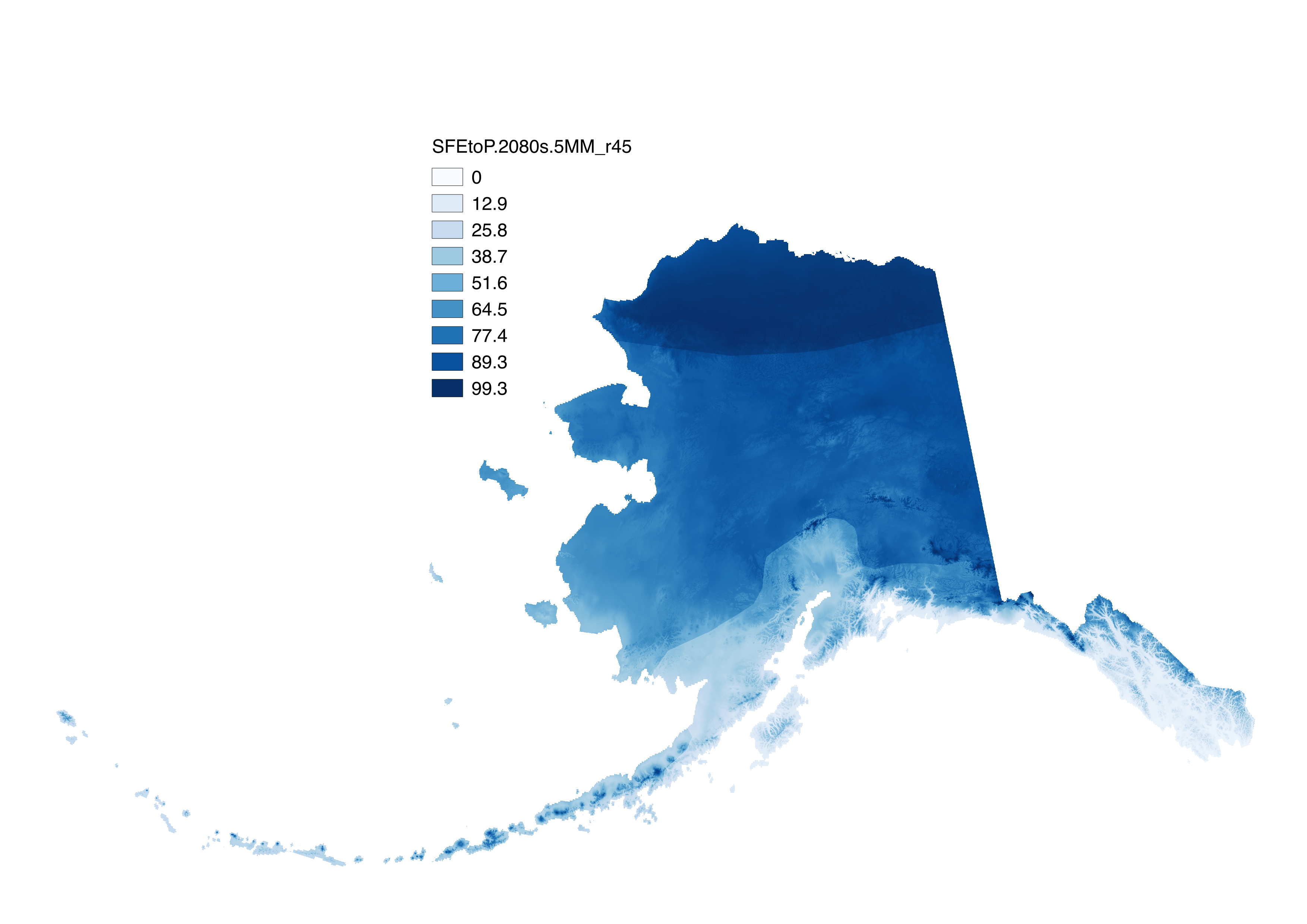
These files include climatological summaries of downscaled historical and projected decadal average monthly snowfall (i.e. snow-water) equivalent (SWE) in millimeters, the ratio of snowfall equivalent to precipitation, and future change in snowfall for October-March at 771-meter spatial resolution across the state of Alaska. Data are for summary October to March Alaska climatologies for: 1) historical and future snowfall equivalent (SWE), produced by multiplying snow-day fraction by decadal average monthly precipitation and summing over 6 months from October to March to estimate the total SWE on April 1. 2) historical and future ratio of SWE to precipitation (SFEtoP), SFEtoP is the ratio of October to March total SWE to October to March total precipitation is calculated as total SWE / total precipitation (expressed as percent, 0-100). 3) future change in snowfall equivalent relative to historical ("dSWE"), calculated as (SWE future – SWE historical) / SWE historical (no units, multiply by 100 to obtain percent). The historical reference period is 1970-1999, (file name “H70.99”), calculated from downscaled CRU TS 3.1 data Future climatologies (both RCP 4.5 and 8.5) are for: - 2020s (2010-2039) - 2050s (2040-2069) - 2080s (2070-2099) across 5 GCMs: NCAR-CCSM4, GFDL-CM3, GISS-E2-R, IPSL-CM5, and MRI-CGCM3 as well as a 5-model mean (“5MM”). Following Elsner et al. (2010), <0.1 is rain dominated, 0.1 < SFE:P < 0.4 is transitional, and >0.4 is snow dominated. Only calculated for historical reference climatology 1970-1999 and three future climatologies: 2010-2039, 2040-2069, and 2070-2090, with each climatology representing the mean of three decadal averages from the available decadal grids. Snow fraction data used can be found here: http://ckan.snap.uaf.edu/dataset/projected-decadal-averages-of-monthly-snow-day-fraction-771m-cmip5-ar5 http://ckan.snap.uaf.edu/dataset/historical-decadal-averages-of-monthly-snow-day-fraction-771m-cru-ts3-0-3-1 Precipitation data used can be found here: http://ckan.snap.uaf.edu/dataset/projected-monthly-and-derived-precipitation-products-771m-cmip5-ar5 http://ckan.snap.uaf.edu/dataset/historical-monthly-and-derived-precipitation-products-771m-cru-ts * Note: In Littell et al. 2018, "SWE" is referred to as "SFE", and "SFEtoP" as "SFE:P"
-
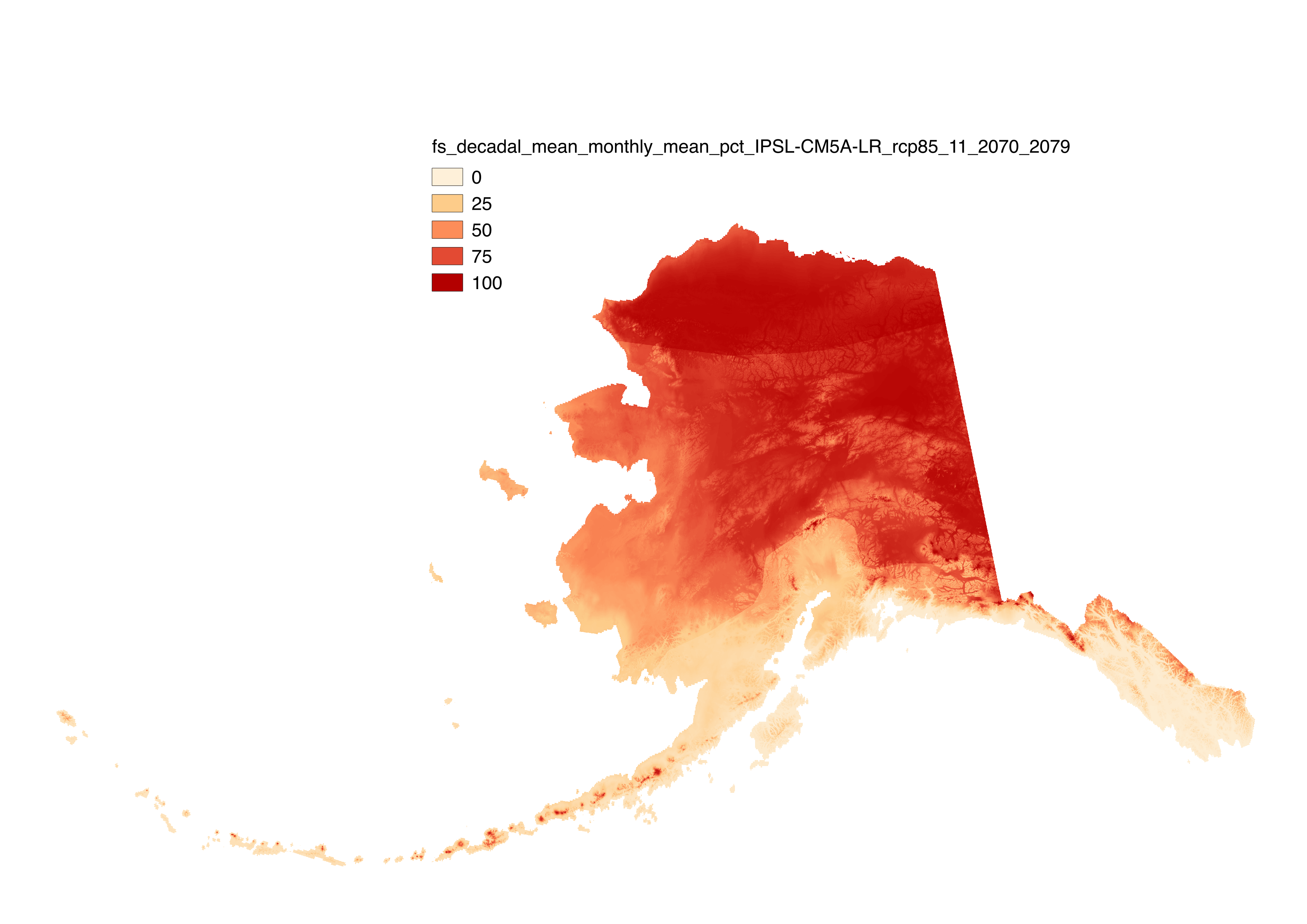
These files include downscaled projections of decadal average monthly snow-day fraction ("fs", units = percent probability from 1 – 100) for each month of the decades from 2010-2019 to 2090-2099 at 771 x 771 m spatial resolution. Each file represents a decadal average monthly mean. Output is available for the CCSM4, GFDL-CM3, GISS-E2-R, IPSL-CM5A-LR, and MRI-CGCM3 models and three emissions scenarios (RCP 4.5, RCP 6.0 and RCP 8.5). These snow-day fraction estimates were produced by applying equations relating decadal average monthly temperature to snow-day fraction to downscaled decadal average monthly temperature. Separate equations were used to model the relationship between decadal monthly average temperature and the fraction of wet days with snow for seven geographic regions in the state: Arctic, Western Alaska, Interior, Cook Inlet, SW Islands, SW Interior, and the Gulf of Alaska coast, using regionally specific logistic models of the probability that precipitation falls as snow given temperature based on station data fits as in McAfee et al. 2014. These projections differ from McAfee et al. 2014 in that updated CMIP5 projected temperatures rather than CMIP3 temperatures were used for the future projections. Although the equations developed here provide a reasonable fit to the data, model evaluation demonstrated that some stations are consistently less well described by regional models than others. It is unclear why this occurs, but it is likely related to localized climate conditions. Very few weather stations with long records are located above 500m elevation in Alaska, so the equations used here were developed primarily from low-elevation weather stations. It is not clear whether the equations will be completely appropriate in the mountains. Finally, these equations summarize a long-term monthly relationship between temperature and precipitation type that is the result of short-term weather variability. In using these equations to make projections of future snow, as assume that these relationships remain stable over time, and we do not know how accurate that assumption is. These snow-day fraction estimates were produced by applying equations relating decadal average monthly temperature to snow-day fraction to downscaled projected decadal average monthly temperature. The equations were developed from daily observed climate data in the Global Historical Climatology Network. These data were acquired from the National Climatic Data Center in early 2012. Equations were developed for the seven climate regions described in Perica et al. (2012). Geospatial data describing those regions was provided by Sveta Stuefer. Perica, S., D. Kane, S. Dietz, K. Maitaria, D. Martin, S. Pavlovic, I. Roy, S. Stuefer, A. Tidwell, C. Trypaluk, D. Unruh, M. Yekta, E. Betts, G. Bonnin, S. Heim, L. Hiner, E. Lilly, J. Narayanan, F.Yan, T. Zhao. 2012. NOAA Atlas 14. Precipitation-Frequency Atlas of the United States.
-
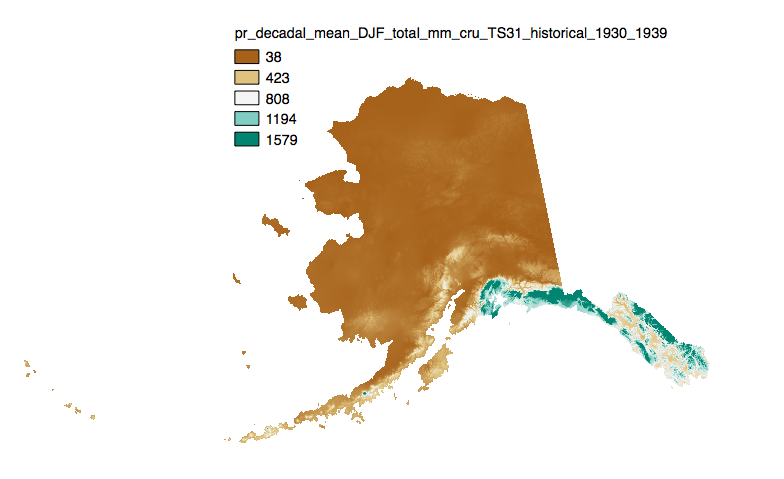
This set of files includes downscaled historical estimates of monthly totals, and derived annual, seasonal, and decadal means of monthly total precipitation (in millimeters, no unit conversion necessary) from 1901 - 2006 (CRU TS 3.0) or 2009 (CRU TS 3.1) at 771 x 771 meter spatial resolution.
-
This data set consists of PRSIM mean air temperature climatologies for Alaska in GeoTIFF format. The files in this data set are available from the PRISM Climate Group as text files but have been processed into GeoTIFFs. These are monthly climatologies with a resolution of 771m. Units are degrees Celsius. There are multiple climatological periods currently available through PRISM, but only one is currently available through SNAP in this dataset: 1971-2000.
-
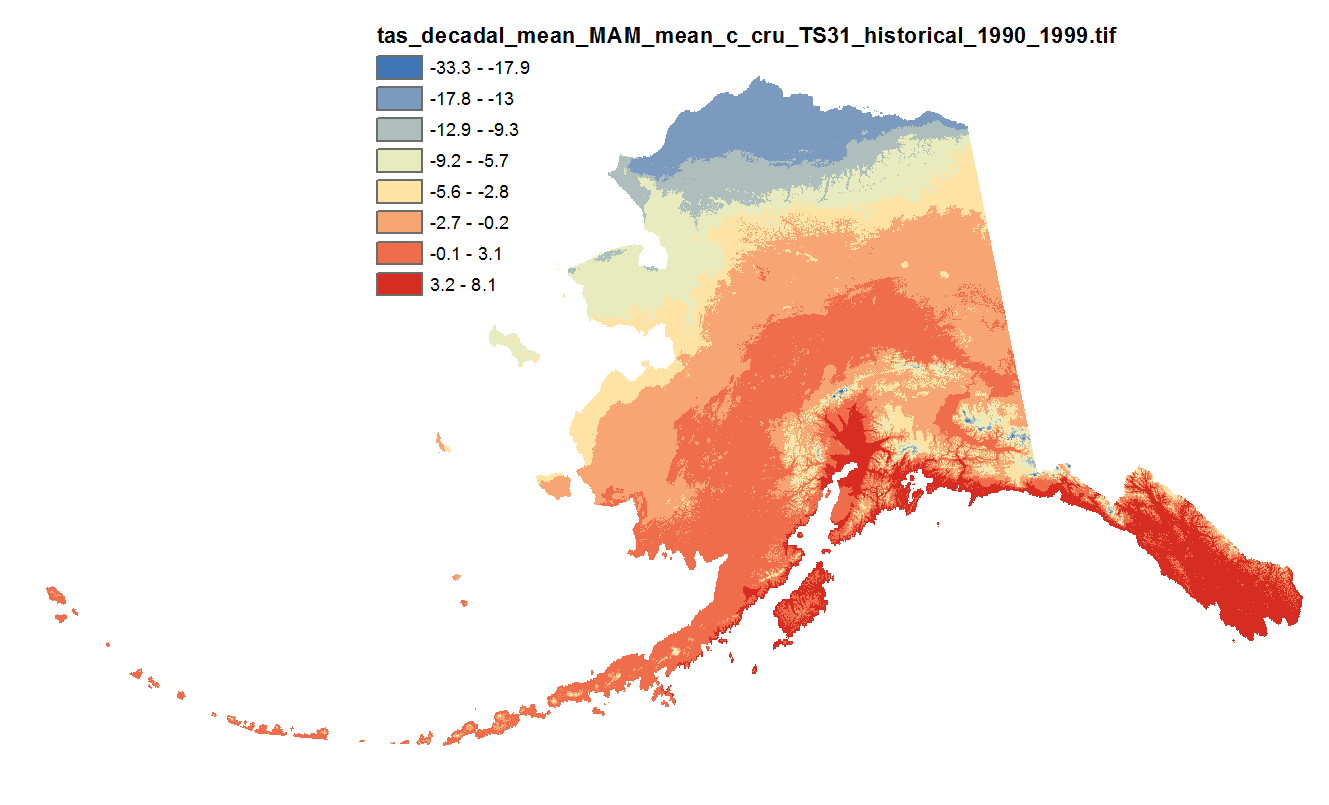
This set of files includes downscaled projections of monthly totals, and derived annual, seasonal, and decadal means of monthly average temperature (in degrees Celsius, no unit conversion necessary) from 1901 - 2006 (CRU TS 3.0) or 2009 (CRU TS 3.1) at 771 x 771 meter spatial resolution.
-
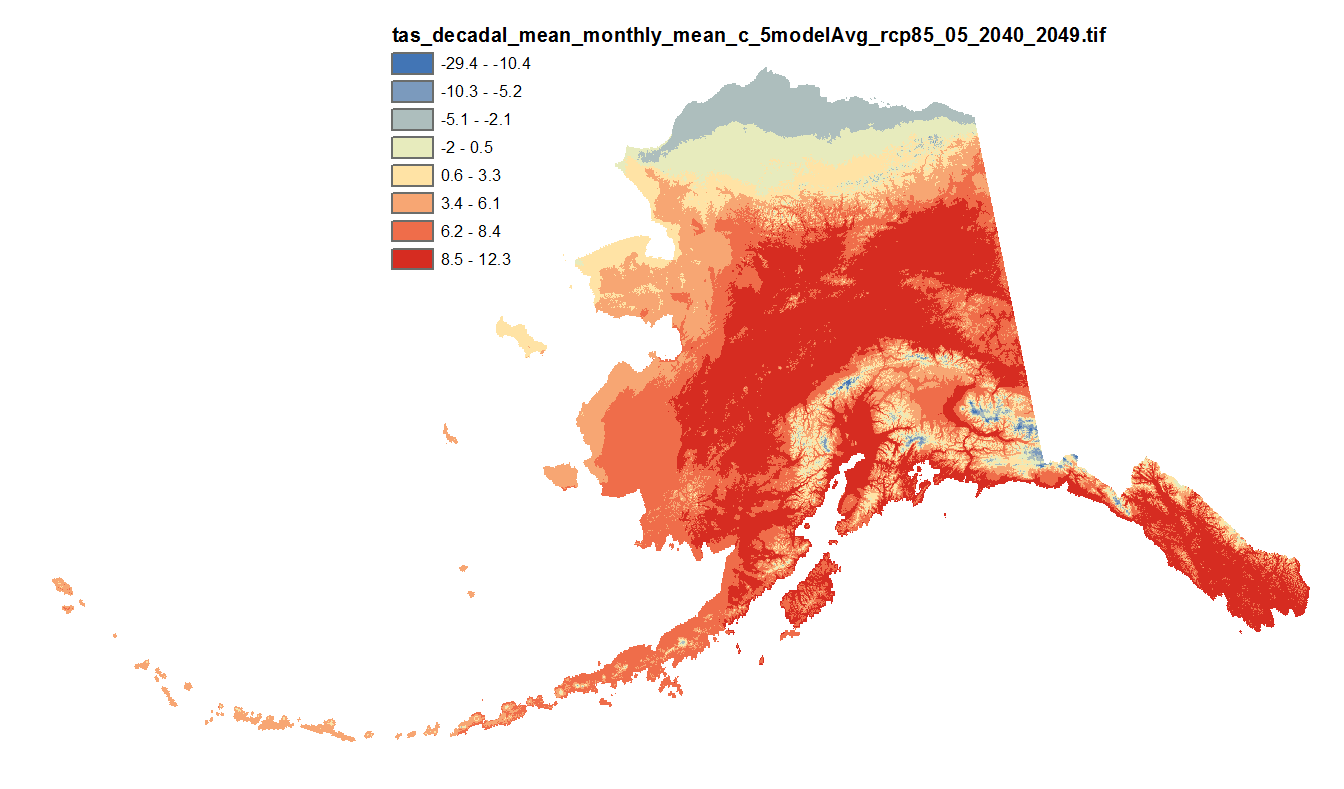
This set of files includes downscaled projections of monthly means, and derived annual, seasonal, and decadal means of monthly mean temperatures (in degrees Celsius, no unit conversion necessary) from Jan 2006 - Dec 2100 at 771x771 meter spatial resolution. For seasonal means, the four seasons are referred to by the first letter of 3 months making up that season: * `JJA`: summer (June, July, August) * `SON`: fall (September, October, November) * `DJF`: winter (December, January, February) * `MAM`: spring (March, April, May) The downscaling process utilizes PRISM climatological datasets from 1971-2000. Each set of files originates from one of five top-ranked global circulation models from the CMIP5/AR5 models and RCPs or is calculated as a 5 Model Average.
-

These files include downscaled projections of decadal average monthly snowfall (water) equivalent (SWE) in millimeters for each month of the decades from 2010-2019 to 2090-2099 at 771 x 771 m spatial resolution. Each file represents a decadal average monthly mean. Output is available for the NCAR-CCSM4, GFDL-CM3, GISS-E2-R, IPSL-CM5A-LR, and MRI-CGCM3 models and three emissions scenarios (RCP 4.5, RCP 6.0 and RCP 8.5). SWE estimates were produced by multiplying snow-day fraction ("fs") by decadal average monthly precipitation ("Pr") such that SWE = (fs * Pr) / 100
 SNAP GeoNetwork
SNAP GeoNetwork